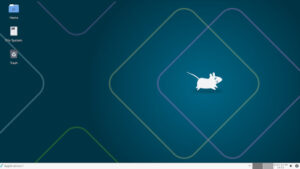Oreon Linux has received a lot of attention for being a desktop OS based on AlmaLinux. However, it appears that the two distros won’t be dancing together for very long.

Whadda you get when you mix a high school age software developer with AlmaLinux? The answer is Oreon Linux, but only until the project lead outgrows it.
The developer is Brandon Lester, a high schooler who calls California’s inland empire home. He says he’s not much of a coder, but he’s good at working with files and systems and seeing the big picture. He’s also evidently good at online wrangling, as he’s managed to put together a team of 10 or so developers who evidently can code to put together a Linux distribution that got reviewed or otherwise covered by more than a few publications in 2024.
“Coding is something that I can say that I’m really bad at,” Lester told FOSS Force in an interview. Actually, I’m good at packaging things and managing a team, but that’s why I have a team — so they can help me code. I’m gonna start learning some coding languages, programming languages because I know basically nothing. So
because I want to help out my team a little bit.
Actually, the very first version of Oreon was based on Fedora, but that release had a problem. It didn’t work — or at least it didn’t offer anything like a good user experience.
“Oreon Linux started off as a hobby project of mine,” he said. “I was kind of getting into Linux a little bit. I kind of messed around with Ubuntu, and then I later got into Fedora which was my favorite distro.”
By January 2024, Lester said he was learning how to put the components together to build a Linux-based operating system.
“That’s when I kind of started learning how to make ISOs and package things,” he said. “So then I created Orion Lime R1, which is the first version. It was a complete failure; it was a mess. The second release, which is our most successful release — Orion lime R2 — is based on AlmaLinux.”
He said that his team, which has been crucial to this endeavor, started to develop after he met and made friends with a coder on Discord with the handle Hellx2.
“We kind of started working together, creating ideas for the project,” Lester said. “Then he kind of spread the word to other people and they joined… and that kept going.”
As might be expected, the team is composed of folks who are mostly, if not all, older than Lester. I wondered if their experience was what led the distro to adopt AlmaLinux as a base after the attempt using Fedora failed.
dis
“Actually, it was entirely my decision,” he said.
My next question was something like, Why AlmaLinux?
The answer to that got sidetracked and I never got around to asking it again.
Oreon Lime R2
The release of Oreon Lime R2 got a little bit of press, probably out of curiosity because it’s based on AlmaLinux 9, a server distro based on a server distro, instead of a distro with some desktop features already built-in.
In an article that ran last January without a byline, the website Linux Social gave readers something of a fifty-cent tour that was generally positive and mentioned security, privacy, and a Windows-like UI as pluses. In August, The Register gave it a deeper delve that had writer Liam Proven scratching his head and using the royal “we” to describe some of the choices that Lester and his team had made, although he did find the distro’s desktop environment to be an improvement over vanilla Gnome, on which it’s based.
“However, it seems to us that the project’s developers have yet to agree on what audience it’s targeting – or even on a coherent version numbering scheme. We are unconvinced by its efforts at gaming, security and development tools, Windows app support and so on.”
On December 9, three days before the release of Oreon 10, Jesse Smith at Distrowatch reviewed Oreon Lime R2 under the mistaken impression that Orion 10 wouldn’t be released until the middle of 2025. While supportive of the distro’s efforts, Smith’s tone was similar to Proven’s:
“Whenever a project tries to turn a primarily server operating system into a desktop experience it tends to feel… well, like a server system with a desktop bolted on top of it. This tends to be true whether we’re looking at Alpine Linux running a desktop, GhostBSD, or (in this case) Oreon. It’s the little things like Gnome software not being able to work on day one because of an add-on repository was missing a GPG file, the mismatched theme, and the giant icons next to tiny text. To be fair to the project, virtually everything works, the system is functional and stable. It’s just that aspects of the experience feel a little ‘off,’ a little unfinished.”
I also looked at Orien Lime 2 on a laptop and found it relatively easy to learn to use, but definitely with a lack of attention to fit and finish. Originally, my plan was to play around with it for a month or more, but a few critical bugs around flatpak installations nixed that plan, so I blew up the install and put Linux Mint back on the machine.
Oreon 10
Oreon 10, which was released on December 12, is probably what I should have installed. Although this release hasn’t yet received as much media attention as Lime, it’s still been fodder for several articles, with a couple of notices coming from publications that primarily cover Windows.
The website Windows Forum, evidently working from a release candidate because the article came out on December 6, called it “a promising alternative to Windows operating systems.” Wayne Williams, writing in Beta News — a website that covers Linux but primarily focuses on Windows — called it “stunning,” and said it “promises to make transitioning to a Linux environment not only approachable but (whisper it!) enjoyable.”
One notable improvement to Oreon 10 includes the inclusion of Flathub in the distro’s app store. Even though flatpaks were included in Oreon Lime, Flathub wasn’t incorporated into the store, although the devs have since made adding it drop-dead easy.
Right now, both versions of Oreon ship with a version of Gnome which has a few modification that media writers have liked. However, it appears that Gnome as the default desktop is on the way out.
“We’re kind of transitioning more towards KDE Plasma, because it’s more stable,” Lester said, adding that he also likes the added configurability that comes with Plasma.
According to the distro’s website, Oreon 10 will be supported until June 1, 2035 — which might be a bit optimistic considering the young age of both the project, and of the project’s leader. It also might be moot, since this will be the last release based on AlmaLinux.
Looking Ahead to Oreon 11
According to Lester, the next version of Orion Linux will not only be running KDE instead of Gnome, it’ll be built from scratch instead of based on another distro.
“We are actually transitioning our entire base again in the next release,” he said. “We’re taking multiple steps further. Eleven is going to be completely independent. No base, no upstream, no nothing. It’s gonna be built from the ground up.”
It appears that “built from scratch” means without relying on Linux From Scratch’s software offerings. And “all new” means the distro’s developers are going to be removing Red Hat’s RPM package manager that’s being used now, and replacing it with Eon, a package manager currently under development for the project that will use a new packaging format called .EPK.
While a brand new, built from scratch, and without technical debt distro might be a good thing in the long run, there is a short term price to pay. The scratch-built Oreon 11 will not be compatible with previous versions of the distro, which pretty much puts the two previous versions in lame-duck status. It also means that the Oreon Project won’t be able to grow its user base much until after the next release date. Lester said that will happen, “probably by early 2026.”










I think it is great that someone like Brandon is heading up this project at his age. I hope that he continues to learn and study more about computer science.
I do have one question about the new packaging format .EPK What problem is it solving that .rpm and .deb do not? I ran across a distribution whose stated sole reason for existence was that their package manager was better than all the others. When I asked them to explain to me what the advantage was, they could not.
If .EPK does something better or solves a deficiency, maybe it is better to try and convince the other packaging systems to correct their deficiency.
This idiot has had half his team abandon him and he immediately discontinued the distro LOL
Dont trust a child to run a Linux disto 🤣
> I think it is great that someone like Brandon is heading up this project at his age. I hope that he continues to learn and study more about computer science.
> I do have one question about the new packaging format .EPK What problem is it solving that .rpm and .deb do not? I ran across a distribution whose stated sole reason for existence was that their package manager was better than all the others. When I asked them to explain to me what the advantage was, they could not.
> If .EPK does something better or solves a deficiency, maybe it is better to try and convince the other packaging systems to correct their deficiency.
I’m a former oreon developer and I created .epk. When I created it, I intended to make it so that it would be easier to package and archive the files offline, so that the packages wouldn’t be lost if upstream was disconnected. However, when the project was completed, Brandon decided to not pay me, and still use the project anyways, saying that “he is a minor and not obligated to pay me”.